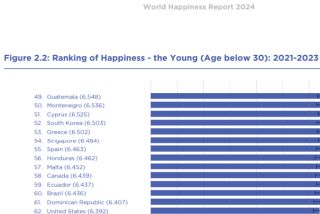Happiness
Mirror Mirror on the Wall, Who's the Happiest of All?
Wide variances in youth and senior happiness mark 2024.
Posted April 3, 2024 Reviewed by Ray Parker
Key points
- In 2024, positive emotions remain more than twice as frequent as negative emotions.
- All generations show large increases in benevolence, but especially so for Millennials and Generation Z.
- New data show feelings of social support are more than twice as prevalent as loneliness in 2022.
- In the USA, the young are unhappier, and seniors are happiest.

Since 2004, the Gallup organization and the United Nations have explored the happiness status of people living in its 143 member countries. There’s a historical basis for such studies. The pursuit of happiness ranks high in the first article of the 1787 preamble of the United States Declaration of Independence, following life and liberty as a “self-evident truth and unalienable right.” Perhaps the authors of the declaration understood that happiness is a win-win pursuit because when policymakers enact programs that support the well-being of their constituents, their happy constituents tend to re-elect them.
The World Happiness Study measures well-being as reported by survey respondents. Called “subjective well-being,” the measure relies on life evaluations as the measure of the quality of people’s lives. The Gallup World Poll asks respondents to evaluate their current life as a whole using the image of a ladder, with the best possible life for them as a 10 and the worst possible life as a zero. World Happiness Report findings comprise the happiness rankings on a three-year average of these life evaluations.
Key 2024 Findings
In 2024, positive emotions remain more than twice as frequent as negative emotions, and feelings of social support are more than twice as prevalent as loneliness. Although both social support and loneliness impact people’s life evaluations, social support has a larger effect because of the social interactions that come with social support.
All generations show large increases in benevolence, but especially so for Millennials and Generation Z, who are even more likely than their predecessors to help others in need.



The 2024 self-reported happiest countries haven’t changed much since 2023. However, the happiness levels of those under 30 and those over 60 have varied widely across the globe. Although the United States scores 23rd on the 2024 happiness scale, people over the age of 60 in the U.S. score 10th in the world for happiness, whereas youth under the age of 30 in the United States rate themselves 62nd on the world happiness scale.
The World Happiness Report confirms that just as with happiness responses by adults, children’s self-reporting of their state of well-being is reliable.

Although the source of significant youth unhappiness in the United States, New Zealand, and Australia is yet to be understood, the influences on happiness are clearer. In both childhood and adolescence family is the primary influence on emotional health, followed by school and community.
The Experience of Youth Impacts Outcomes in Adulthood
Positive youth life experiences are important because studies find that the best predictor for adult life satisfaction is subjective well-being and emotional health during childhood. Youth happiness significantly influences other later life outcomes, such as labor market success, levels of income in adulthood, physical health, and relationships.
Globally, two of the primary drivers of youth unhappiness are material deprivation and relationships with parents and peers. These are areas where policy interventions can make a significant impact. Other influential drivers of youth happiness levels include health, physical activity, time use, neighborhood safety, and children’s rights. On a macro level, government spending on families and education as a percentage of gross domestic product (GDP) are factors.
The World Happiness Report of 2024 points to childhood and adolescence as periods of considerable importance and a unique window of opportunity for intervention to make strong and positive impacts worldwide to ensure higher global well-being.
References
Helliwell, J. F., Layard, R., Sachs, J. D., De Neve, J.-E., Aknin, L. B., & Wang, S. (2024). World Happiness Report 2024. University of Oxford: Wellbeing Research Centre.
Taylor, L., Boyle, L., Zhou, W., De Neve, J., & Marquez, J.(2024). 2024 World Happiness Report. Chapter 3 "Child and Adolescent Well-Being: Global Trends, Challenges and Opportunities." Wellbeing Research Centre, University of Oxford, UK & University of Manchester Institute of Education, UK. doi.org/10.18724/whr-91b0-ek06.


